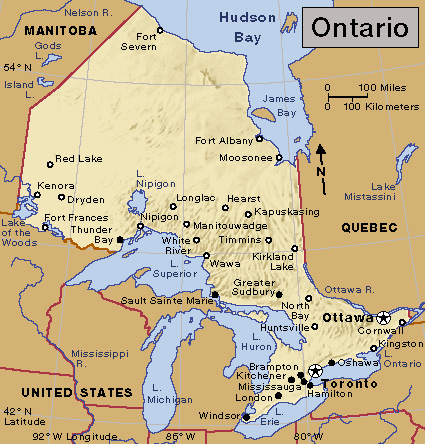Greater Sudbury, Ontario (pop. 166,004), is a world center of nickel production. Mines in and near the city produce a significant portion of the world’s nickel supply. Greater Sudbury, often called the Nickel Capital of the World, lies in eastern Ontario.

Greater Sudbury has a mayor-council government. Most of Greater Sudbury’s people have English or French ancestors. The city is the home of Laurentian University, where many classes are taught in both English and French. Greater Sudbury is the health-care center for its region. It has also become a center for federal and provincial government offices.
Mining ranks as one of Greater Sudbury’s chief economic activities. Many of the workers in the metropolitan area are employed by companies that mine and process the rich ores found in the area. Nickel and copper are Greater Sudbury’s chief products. In addition, precious metals such as gold and platinum are mined and processed in the Greater Sudbury area.
The Ojibwa were the main aboriginal (native) group living in what is now the Greater Sudbury area when white settlers first arrived. In 1883, the Canadian Pacific Railway established the first permanent settlement there. James Worthington, the head of a railroad construction crew, named it Sudbury, for the town of Sudbury in Suffolk, England—his wife’s birthplace. Also in 1883, the railroad’s construction crews discovered the world’s richest copper-nickel deposits near Sudbury.
Sudbury’s first copper-mining company was formed in 1886. Major mining operations began after 1892, when a practical process for separating copper and nickel was developed. Sudbury was incorporated as a town in 1893. Its population rose from 795 that year to 18,075 in 1930, when it was incorporated as a city.
Two of the world’s largest nickel-mining companies—Inco Limited (now part of Vale) and Falconbridge Limited (now part of Glencore plc)—were founded in the Sudbury area in the early 1900’s. The city prospered during World War I (1914-1918) and World War II (1939-1945) because of the great demand for nickel. Manufacturers used nickel to make ammunition and armor plating. In 1950, the city had 42,410 people. In 1960, the city annexed several adjoining townships, and its population jumped to about 80,000.
Through the years, the city’s copper and nickel plants have caused much air pollution. In the early 1970’s, the provincial government ordered the mining companies to greatly reduce the amount of harmful gases discharged into the air. One mining company responded by building a smokestack that spread the gases over a large area, thus reducing the pollution in Sudbury. The smokestack, completed in 1972, rises 1,250 feet (381 meters) and is one of the tallest in the world.
During the 1970’s, Sudbury began a project to replant land damaged by logging and mining. By the early 1990’s, about 40 percent of the damaged land had been replanted with trees and grasses.
On Jan. 1, 2001, the enlarged city of Greater Sudbury was formed. Greater Sudbury includes the urban and rural areas that had been part of the region of Sudbury and the municipalities of Capreol, Nickel Centre, Onaping Falls, Rayside-Balfour, Sudbury, Valley East, and Walden.
